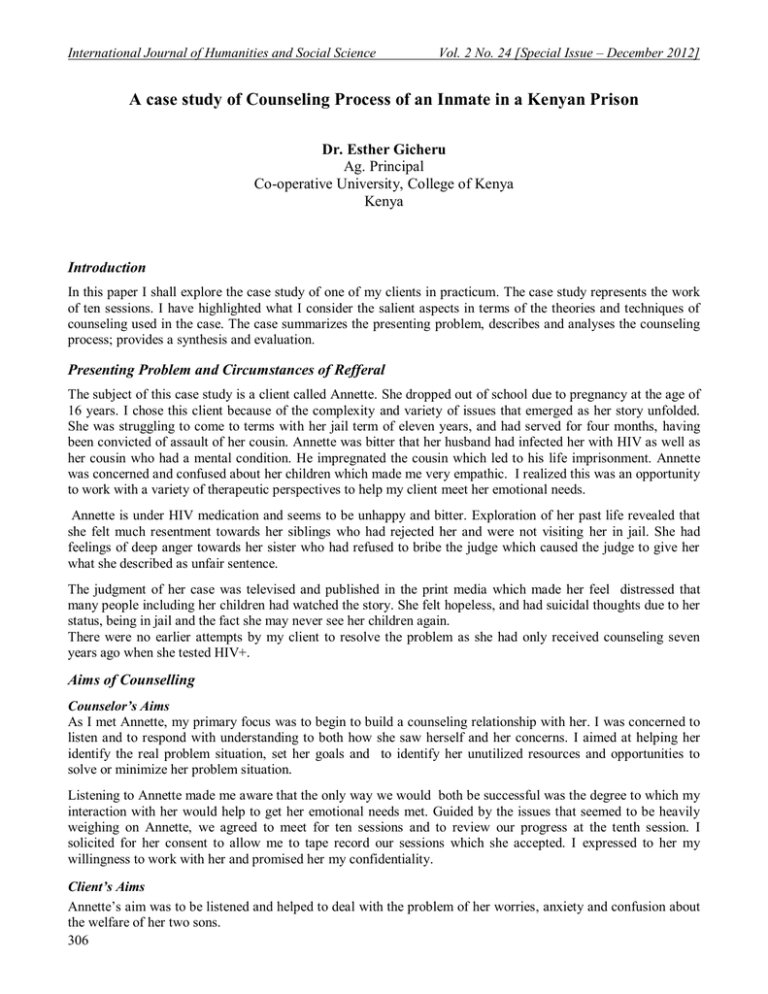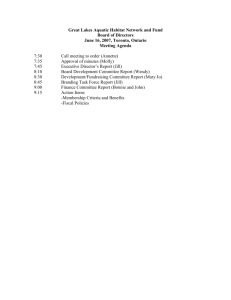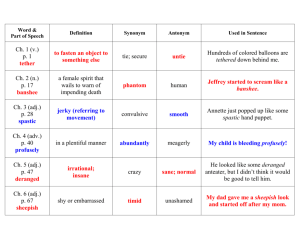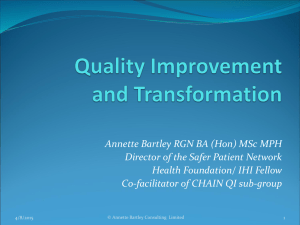Document 10464870
advertisement

International Journal of Humanities and Social Science Vol. 2 No. 24 [Special Issue – December 2012] A case study of Counseling Process of an Inmate in a Kenyan Prison Dr. Esther Gicheru Ag. Principal Co-operative University, College of Kenya Kenya Introduction In this paper I shall explore the case study of one of my clients in practicum. The case study represents the work of ten sessions. I have highlighted what I consider the salient aspects in terms of the theories and techniques of counseling used in the case. The case summarizes the presenting problem, describes and analyses the counseling process; provides a synthesis and evaluation. Presenting Problem and Circumstances of Refferal The subject of this case study is a client called Annette. She dropped out of school due to pregnancy at the age of 16 years. I chose this client because of the complexity and variety of issues that emerged as her story unfolded. She was struggling to come to terms with her jail term of eleven years, and had served for four months, having been convicted of assault of her cousin. Annette was bitter that her husband had infected her with HIV as well as her cousin who had a mental condition. He impregnated the cousin which led to his life imprisonment. Annette was concerned and confused about her children which made me very empathic. I realized this was an opportunity to work with a variety of therapeutic perspectives to help my client meet her emotional needs. Annette is under HIV medication and seems to be unhappy and bitter. Exploration of her past life revealed that she felt much resentment towards her siblings who had rejected her and were not visiting her in jail. She had feelings of deep anger towards her sister who had refused to bribe the judge which caused the judge to give her what she described as unfair sentence. The judgment of her case was televised and published in the print media which made her feel distressed that many people including her children had watched the story. She felt hopeless, and had suicidal thoughts due to her status, being in jail and the fact she may never see her children again. There were no earlier attempts by my client to resolve the problem as she had only received counseling seven years ago when she tested HIV+. Aims of Counselling Counselor’s Aims As I met Annette, my primary focus was to begin to build a counseling relationship with her. I was concerned to listen and to respond with understanding to both how she saw herself and her concerns. I aimed at helping her identify the real problem situation, set her goals and to identify her unutilized resources and opportunities to solve or minimize her problem situation. Listening to Annette made me aware that the only way we would both be successful was the degree to which my interaction with her would help to get her emotional needs met. Guided by the issues that seemed to be heavily weighing on Annette, we agreed to meet for ten sessions and to review our progress at the tenth session. I solicited for her consent to allow me to tape record our sessions which she accepted. I expressed to her my willingness to work with her and promised her my confidentiality. Client’s Aims Annette’s aim was to be listened and helped to deal with the problem of her worries, anxiety and confusion about the welfare of her two sons. 306 The Special Issue on Current Trends in Social Science © Centre for Promoting Ideas, USA www.ijhssnet.com She wanted to be helped to work out how her son who had completed class eight would be educated. She wanted to be helped to obtain information about her ailing husband who was in jail and also to have her relatives visit her in jail and bring along her children. Approach to Counseling My approach to counseling would be to listen carefully to Annette’s concerns in order to understand the problem in need of solution. I intended to use Person Centered approach whereby my role as a counselor would be to create a permissive and non-directive climate for my client’s self directed growth. Carl Rogers as quoted by J. Fuster, postulates that the client is the best source of information about herself, and that she could diagnose herself if she were adequately helped by the counselor (Fuster, J 2008). I would help my client by using the techniques of reflecting and clarifying the verbal and non verbal communications while focusing on her phenomenological world. This would help me to understand how my client is behaving from her own internal frame of reference. With the psychoanalytic approach I helped her to explore how her childhood life may have contributed to her current problem situation. This would help me to detect any traces of resistance such as ideas, attitudes, feelings or actions that may foster the status quo of my client and get in the way of change. Corey (2009), asserts that through relationship with the therapist clients experience and express, feelings, beliefs and the desires that they have buried in the unconscious. Through appropriate interpretations and working through the current expressions of early feelings, clients are able to change some of their long standing patterns of behavior. I would often use gestalt approach to help my client to locate the ways in which she may be blocking her energy and to transfer it into more adaptive behavior. According to Corey, gestalt therapy is an experiential approach that stresses present awareness and the quality of contact between the individual and the environment (Corey, 2009). By applying Rational Emotive Behavioral Therapy approach, that is, use of action and practice to help my client reduce or eradicate the irrational self defeating thoughts. The philosophy of Rational Emotive Behavioral Therapy as articulated by Corey is that individuals are born with potential for rational thinking but they tend to fall victim to the uncritical acceptance of irrational beliefs (Corey, 2009) Working with these theoretical approaches, at the initial stage helped my client to tell her story, prioritize and be focused to determine in what order she would tackle her concerns. In the middle stage, I reassessed the problems of my client to help her see herself from different and more empowering perspectives. In the end stage I intended to help my client to plan for and take effective action leading to minimizing or solving her problems. Counseling Annette was disappointed in life and had fears, uncertainties and confusion brought about by her imprisonment. She had explained about a number of her concerns including her feelings of depression, distress and anxiety regarding her two sons whom she had left behind. During the initial stage, Annette largely blamed her sister whom she described as having rejected her. As I listened to her and the intensity of her problem situation, I empathized with her. At times my empathy bordered on sympathy especially regarding her children’s whereabouts. As a mother this greatly touched me. Annette requested me to help her find out where her children were and gave me the telephone contact of her sister. This request caught me unawares and I quickly realized it presented an ethical dilemma for me. I was overwhelmed by her issues relating to her health, her hopelessness in life, her separation from her children and rejection by her family members. I presented this case for supervision and got very useful feedback which made me realize the need to identify my task in counseling as one of helping Annette to explore and get insights of solving her problem situation but not me attempting to solve the problems for her. Annette desperately longed to have a breakthrough in getting to know about the situation of her two sons. She expressed feelings of desperation due to her HIV status. 307 International Journal of Humanities and Social Science Vol. 2 No. 24 [Special Issue – December 2012] I planned to help Annette to diminish the fear and anxiety that had dominated her life. I prompted her to get in touch with the prison’s welfare office to contact her sister to find out about the children. Annette agreed and promised to give me feedback during the next session. This greatly helped her to personalize her problem. There was no much progress and in the next session she appeared to be unhappy. Using the here and now approach, I brought my observation to her awareness. She responded by indicating that I had missed the previous session which made her worried. This made me reflect on my relationship with my client and wondered whether I may have allowed either a sense of dependency to develop or lack of trust. I took time to explain to her about my absence and reiterated my commitment to working with her. Annette’s stated priority was to know the fate of her children. I reviewed my aims of counseling Annette and realized she needed to come to terms with her feelings about being in jail for the next eleven years. We explored on the life in jail and she described life in prison as ‘’very difficult’’. She complained about the harshness of her superiors which greatly stressed her, and the bad character of the inmates who were involved in tobacco and bhang smoking. She deplored the lack of freedom which made her cry every night. I challenged her to think about her well being which would help her survive to the eleven years and see her children again. Annette expressed her conviction that she would not live for long in such bad conditions. She explained the difficulties she had in getting drugs for her HIV condition which made her feel desperate and hopeless. I encouraged her to work towards developing good relationships with her supervisors as well as the inmates. During one of the ensuing sessions, Annette came in looking happy and relaxed. She jubilantly explained that the welfare office had eventually succeeded in talking to her sister and learned that she had taken custody of the children. Annette expressed her happiness to learn that her elder son had passed very well and joined a national school. I affirmed her for taking initiative to follow up the matter with the welfare office which had resulted in such exiting information. I felt that this was a big breakthrough for my client. I challenged Annette to start looking at her sister positively given that she had taken the responsibility of looking after her children. Annette concurred and expressed her joy about it. She described her feeling of joy after the doctor had confirmed that her CD4 count had actually increased. At this point, I knew I had an opportunity to move my client to another level. Although she acknowledged relief because of the positive things happening in her life, she quickly reflected and narrated about her life in jail. She was in denial and depressed about her imprisonment. I helped her to reflect on the purpose of her life to which she responded, she doubted if there was God. I could identify with Annette’s feelings of frustration. I brought to her attention that I was aware acceptance of the new life in jail was a process. I encouraged her to get into the habit of reading books at bed time to induce sleep and recreate hope in her. I concluded that I would take the case for supervision to be helped to explore how to move her from her denial of imprisonment. In the next session, Annette came in complaining that her sister had once more refused to pick her call. She expressed feelings of anger towards her. While I encouraged her not to give up calling her sister, I took the opportunity to bring up the issues that had arisen from supervision. My supervisor had led me to new insights into the case. We had explored the problem situation and identified that my client was experiencing different types of losses. These losses included: loss of her late father, loss due to separation with her children, loss of health due to her HIV+ condition, loss of family due to her imprisonment, loss of marriage because her husband had been jailed for life. The supervision had also brought out the issues of her husband’s infidelity and the shock and hopelessness brought about by her imprisonment. I brought these areas to Annette’s awareness and she confirmed that these were areas she would like to work on one by one. In addressing the losses, it came out that Annette was hurting and sad. She imagined the sad feelings of her children in knowing that their parents were in jail and HIV+. The fact that the judgment of her case was televised and written in the newspapers made her feel hopeless. She described how she felt disturbed at the thought that she may never see her children again which made her cry often and lose appetite. 308 The Special Issue on Current Trends in Social Science © Centre for Promoting Ideas, USA www.ijhssnet.com We worked together to deal with the feelings that she experienced because of these losses. My supervisor had advised me to read materials on loss and grief which helped me to take her through the grief cycle starting from shock, anger, denial leading to acceptance of her loses and moving on with life. In later sessions, I confronted my client to think of other members of her family, who could give her support. After a period of struggle she managed to talk to her brother. Annette’s major concern at this point was to get somebody who could bring her children to the family day visit which was due in a month’s time. She was feeling desperate to see her children. I encouraged Annette not to give up but to have an open mind about the visit. With regard to her HIV+ status, I encouraged my client to adopt a positive living attitude. I challenged her to think of the people she knew who were HIV+ and had lived for long. She gave me an example of her cousin who had lived with the condition for 22 years. This helped her to realize that she could also live long and should stop being preoccupied with death. I further challenged her to tell me if there were other inmates who were never visited by their relatives. She told me of a Muslim girl who had been sentenced to life imprisonment; had served for nine years and nobody had ever gone to see her, yet she looked happy and well. This made my client realize she was not alone. From the supervision, I had picked the need to challenge my client to look at her past and see whether she had in any way contributed to the situation she was in. This helped Annette to analyze her past and to accept her mistakes in involving herself with heavy drinking of alcohol during the period of her trial. She expressed disappointment with herself and wondered what might have gone wrong with her. The use of gestalt approach brought the restoration of awareness in my client by reliving her past experience. I knew this was another breakthrough point for Annette to stop blaming others for her situation. I helped my client to develop positive thinking and positive self talk. I affirmed her for her good English despite having dropped out of school at form two and, unlike her sisters, she was in a marriage and blessed with children. In the sessions that followed we worked with the rest of the areas of loss that we had agreed on. Annette was getting more positive. She started doing exercises which helped much to boost her health and self esteem. I noticed that in every session, Annette, would bring the issue of her children. In one session she explained how she was stressed because of dreams about her children. She feared that her children might forget and even reject her when she would be released from jail. I helped her to be positive about her children. Annette continued to describe the stressful conditions in jail. She narrated how the rampant acts of lesbianism disturbed her. I encouraged her to work on her behavior to ensure that one day she would leave the ‘’special watch ward’’ and move to an ordinary ward where there was less misconduct by the prisoners. In a later session she expressed her feelings of joy and relief having moved to an ordinary ward. In the following session, I aimed to move my client to a higher level. I challenged Annette to start thinking of her purpose in life beyond prison. I prompted her to think about the option of government wanting to release some prisoners because the prisons were congested. She felt encouraged and in agreement that she had to sustain good conduct and aim to benefit from any such government reviews. In later sessions, Annette was comfortably talking about her plans when out of jail. She looked forward to tell her true life story in prison as a HIV+ survivor in the Parent Magazine. By the last session, I had already prepared my client for termination. She looked depressed as she gave me information of her sick mother which she learned from her sister. We explored this and I challenged her to see her sister’s goodwill because she informed her about the mother. She described the recent results of her CD4 count as very good. Annette brought a new dimension to her relations when she described her elder son as having rejected her because she had met her with a man who was a friend to her and the son assumed he was a ‘’boyfriend’’. We agreed to explore the new issue in extended sessions. We looked at the process we had gone through. Annette was coming to terms with living in jail. We reviewed all the issues that she had brought for counseling. She described the counseling as having worked well for her. I was impressed by the way Annette described herself. We agreed to meet for an additional four sessions to deal with the outstanding issues. 309 International Journal of Humanities and Social Science Vol. 2 No. 24 [Special Issue – December 2012] Synthesis In working with Annette, we were able to explore several areas of her life. She had difficulties in living in jail with no information of her two sons’ welfare and with none of her family members or friends visiting her. This elicited feelings of anger and frustration to an extent of her contemplating suicide. In the process of counseling, various themes came up: At the beginning, we worked on helping my client tell her story, develop new perspectives and setting priorities to work on issues that would make a difference in her life. I used Egan’s model stage I, as reflected in Gerald Egan’s skilled helper (Egan, 2007). The counseling process dealt with issues of feelings such as frustration, confusion, anger, sadness, depression, loss and grief, self pity, resentfulness, rejection, stigmatization among others. Annette felt resentful because she was rejected by her family because of her involvement in heavy drinking of alcohol as well as her HIV+ conditions. In her culture, there is stigmatization of people, especially women who are alcoholic and infected with HIV. Annette was able to realize that her self esteem was low and that was why she felt rejected by people. At times during the counseling process, ethical issues emerged, such as when Annette believed that I was in a position to get involved in contacting her sister and children whom she was desperate to see. It became clear that my client had not had an opportunity to express her feelings since she was jailed. The counseling process provided a forum for her to express her feelings and reflect on her life. In the later phase of counseling, Annette’s growth is manifested in a personally meaningful definition of herself as well as her physical self care. She no longer talked of her death. . She had the awareness that she was likely to experience stress but she was confident that she could now handle her life situations better. She was now able to visit relevant offices at the prison to have her rights addressed. Self Evaluation Working with Annette made me become more aware of my strengths and weaknesses. I realized I had developed good listening and empathetic skills. I had greatly improved in my genuineness and concreteness attitudes. At the beginning, I was very anxious and as we progressed I became more confident and more focused. The process helped me to understand the value of supervision. The supervision helped me to identify themes that had not been obvious to me. It helped me articulate my role as a counselor. Supervision helped me to identify areas where I was not challenging my client enough and to be conscious of any manipulative signs by my client and how to handle them. Supervision also helped me to identify my strengths in empathizing, listening, summarizing and paraphrasing. During supervision it came to light that I was trying to see how I could solve my client’s problems. Supervision helped me identify my task in counseling as that of helping the client explore and equip her with skills to meet her emotional needs. Weaknesses Sometimes my client would tend to talk very little and at such times I would tend talk more and to give advice to my client. On hindsight I realize that I did not pay much attention to Annette’s position as a last born child in a large family where she may have been pampered by both parents and family, which may have contributed to her craving for attention and hence the strong feelings of rejection. Strengths Use of person centered approach helped me to express my values, reactions and feelings as they became appropriate to what was happening in the therapy sessions. It helped me to create a trusting working relationship with my client. In the process I found it necessary to introduce Gestalt approaches to handle the issues of my client’s awareness of her environment. 310 The Special Issue on Current Trends in Social Science © Centre for Promoting Ideas, USA www.ijhssnet.com When I wanted her to think of alternative solutions to her problem situation, I would become cognitive and challenge my client to think and analyze situations. I used Albert Ellis’s Rational Emotive Behavioral Therapy. Ethical Issues When my client would talk about not getting the daily utilities like soaps from her relatives, I would feel tempted to ask the welfare officer to allow me to buy them for her. I then realized this was to create an ethical dilemma and stopped. Some of the difficulties I encountered included time management. There are times I would visit the counseling site and find they had other programmes and so I could not see my clients. Other times my duties in the office interfered with my programme and I could not strictly follow my schedule as agreed with the client. Conclusion At the time of writing this case study I had terminated with my client in the tenth session and contracted for four more. I had done two sessions out of the four and surprisingly in the first session the client opened with new information regarding her first born son who actually was not sired by her husband. I interpreted the bringing of a likely heavy issue at the end session to indicate anxiety about separation. The experience with this client gave me many insights as to what one can expect in a counseling process. References Corey G, (2009) Case Approach to Counselling and Psychotherapy: 7th Ed., Thomson, Drooks/Cole Corey, G. (2009) Theory and Practice of Counselling and Psychotherapy 8th Ed. Belmont, CA. Brooks/Cole (Thomson/Wadrworth) Culley J. (1996) Integrative Counselling Skills in Action: 6th Ed. Sage Publications Ltd. Egan G. The Skilled Helper: A Problem-Management Approach to Helping: Brooks/Cole, 1994. Page 2. 2. Fuster J. M. (2008) Personal Counselling Better 14th Ed.Yourself Books, 23rd Road, TPS III, Bandra Mumbai Sue Culley (1996) Integrative Counselling Skills in Action 5th Ed. Sage Publications London Thousand Oakes New Delhi 311






